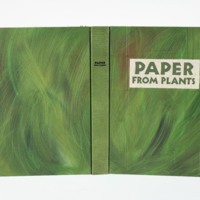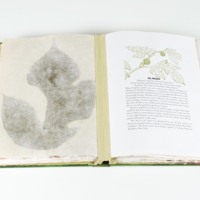A97. Paper From Plants
A97. Peter and Donna Thomas, compilers. Paper From Plants. Santa Cruz, California: Peter & Donna Thomas, 1999.
29.5 x 22 cm (11 5/8” x 8 ¾”), 100 pages, 150 copies.
Binding: Copies 1-15 full-bound in green Morocco leather. Raised geometric design on cover. Title on pampas grass paper label on cover. Title stamped in black on spine. Housed in a green paper wrapper tied with a bronze ribbon. Copies 16-150 quarter-bound in green Morocco leather and green painted paper. Raised geometric design on cover. Title on pampas grass paper label on cover. Title blind stamped in black on spine. Housed in a green commercial paper wrapper tied with a bronze ribbon. Copies 1-15 and miscellaneous others housed in slipcase covered in painted paper. Paper: Text printed on white cotton paper handmade by Peter Thomas. Printing: Letterpress. Illustrations printed from photoengravings. Typography: Hand set Centaur and Neuland; titles in light green. Illustration: 30 paper samples bound in. Reproductions of thirty-one line drawings by Donna Thomas; printed in light green. Illustrations hand-colored in copies 1-15. Notes: Paper made using an English double mould.
“This book is a companion volume to our earlier work, A Collection of Paper Samples from Hand Paper Mills in the United States of America [A74]. It presents a cross-section of papers made from local plants by America’s hand papermakers. In contrast to our earlier volume, the papermakers who contributed to this book represent all levels of expertise and act as proof that beautiful paper can be made from plants with a bare minimum of equipment or experience. Some of the papermakers worked with plants they loved, like iris and sweet pea from the garden. Others made their paper as a statement: to legalize the use of certain plants; to spur the eradication of invasive non-native plant species. Still others used industrial by-products to create commercial handmade papers. It has not been easy to complete this book. It took thousands of hours to process the plants and to make the 4,350 sheets of paper necessary for the edition. Unexpected problems came up: Marilyn Sward’s Spanish moss was confiscated by the DEA when she shipped it from Florida to her home in Chicago. Neil Bonham had a terrible allergic reaction to the Daphne he used, and David Kimball could not even make his paper because of an adverse reaction to the poison oak he had harvested for the project.
Because making pulp from plants requires so much more work than from rag, we decided to let the papermakers send us 8.5x11 inch sheets, rather than 11x17 sheets as they had for A Collection of Paper Samples. This created a problem. As we were thinking of the two books as companion volumes we wanted to make the same general size and design. But since the paper was half the size, if it was folded in half to sew, then the book would be half the size. We had been teaching non-adhesive binding techniques in the workshops we were offering at the time, and had been experimenting with ways to bind single sheets of paper, and used one of the ideas we had worked out for the pleated spine binding structure for this book. In those classes we often had our students decorate the cover paper with acrylic paint, and so used that same technique for the covers of this book.”

